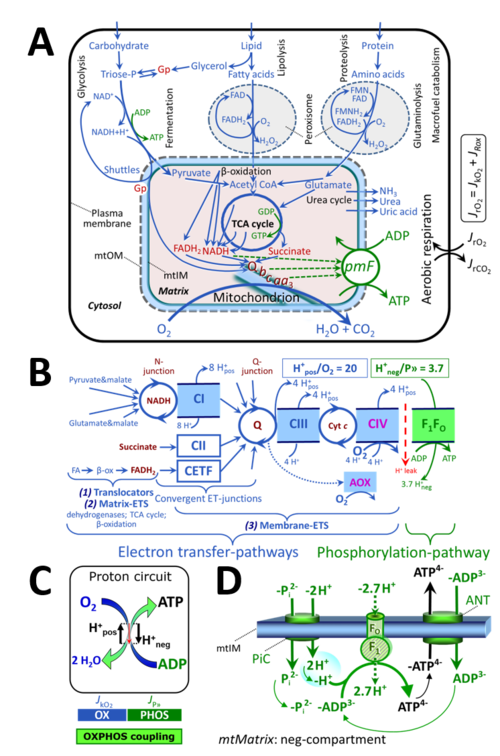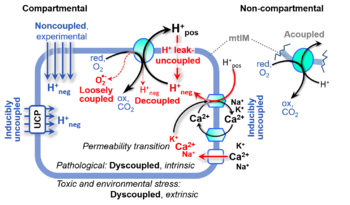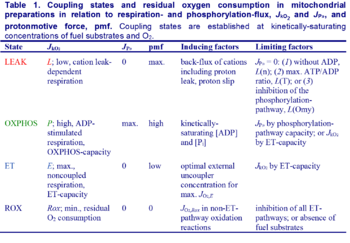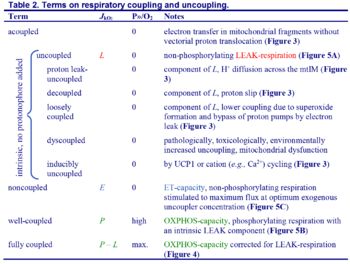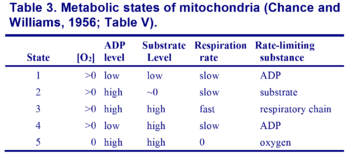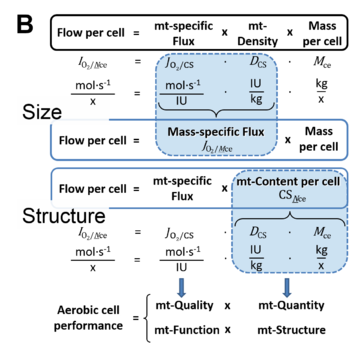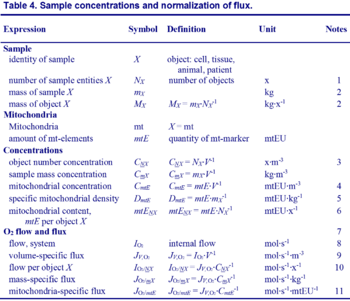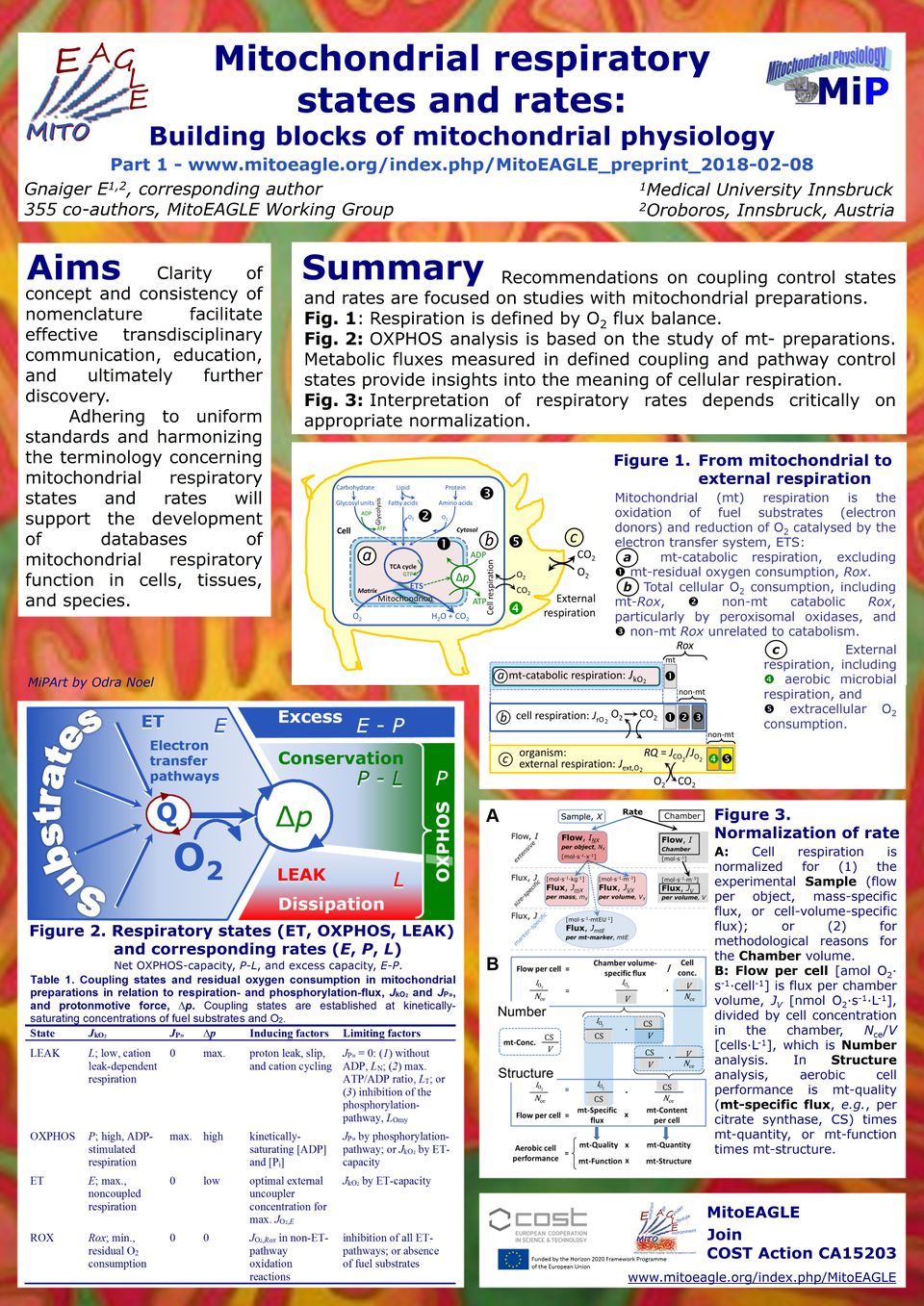| News and Events | Working Groups | Short-Term Scientific Missions | Management Committee | Members |
COST Action CA15203 (2016-2021): MitoEAGLE
Evolution-Age-Gender-Lifestyle-Environment: mitochondrial fitness mapping
MitoEAGLE Task Group States and rates
| Gnaiger E, Aasander Frostner E, Abdul Karim N, Abumrad NA, Acuna-Castroviejo D, Adiele RC, Ahn B, Ali SS, Alton L, Alves MG, Amati F, Amoedo ND, Andreadou I, Arago M, Aragones J, Aral C, Arandarcikaite O, Armand AS, Arnould T, Avram VF, Bailey DM, Bajpeyi S, Bajzikova M, Bakker BM, Barlow J, Bastos Sant'Anna Silva AC, Batterson P, Battino M, Bazil J, Beard DA, Bednarczyk P, Bello F, Ben-Shachar D, Bergdahl A, Berge RK, Bergmeister L, Bernardi P, Berridge MV, Bettinazzi S, Bishop D, Blier PU, Blindheim DF, Boardman NT, Boetker HE, Borchard S, Boros M, Borsheim E, Borutaite V, Botella J, Bouillaud F, Bouitbir J, Boushel RC, Bovard J, Breton S, Brown DA, Brown GC, Brown RA, Brozinick JT, Buettner GR, Burtscher J, Calabria E, Calbet JA, Calzia E, Cannon DT, Cano Sanchez M, Canto AC, Cardoso LHD, Carvalho E, Casado Pinna M, Cassar S, Cassina AM, Castelo MP, Castro L, Cavalcanti-de-Albuquerque JP, Cervinkova Z, Chabi B, Chakrabarti L, Chakrabarti S, Chaurasia B, Chen Q, Chicco AJ, Chinopoulos C, Chowdhury SK, Cizmarova B, Clementi E, Coen PM, Cohen BH, Coker RH, Collin A, Crisostomo L, Dahdah N, Dalgaard LT, Dambrova M, Danhelovska T, Darveau CA, Das AM, Dash RK, Davidova E, Davis MS, De Goede P, De Palma C, Dembinska-Kiec A, Detraux D, Devaux Y, Di Marcello M, Dias TR, Distefano G, Doermann N, Doerrier C, Dong L, Donnelly C, Drahota Z, Duarte FV, Dubouchaud H, Duchen MR, Dumas JF, Durham WJ, Dymkowska D, Dyrstad SE, Dyson A, Dzialowski EM, Eaton S, Ehinger J, Elmer E, Endlicher R, Engin AB, Escames G, Ezrova Z, Falk MJ, Fell DA, Ferdinandy P, Ferko M, Ferreira JCB, Ferreira R, Ferri A, Fessel JP, Filipovska A, Fisar Z, Fischer C, Fischer M, Fisher G, Fisher JJ, Ford E, Fornaro M, Galina A, Galkin A, Gallee L, Galli GL, Gama Perez P, Gan Z, Ganetzky R, Garcia-Rivas G, Garcia-Roves PM, Garcia-Souza LF, Garipi E, Garlid KD, Garrabou G, Garten A, Gastaldelli A, Gayen J, Genders AJ, Genova ML, Giovarelli M, Goncalo Teixeira da Silva R, Goncalves DF, Gonzalez-Armenta JL, Gonzalez-Freire M, Gonzalo H, Goodpaster BH, Gorr TA, Gourlay CW, Granata C, Grefte S, Guarch ME, Gueguen N, Gumeni S, Haas CB, Haavik J, Haendeler J, Haider M, Hamann A, Han J, Han WH, Hancock CR, Hand SC, Handl J, Hargreaves IP, Harper ME, Harrison DK, Hassan H, Hausenloy DJ, Heales SJR, Heiestad C, Hellgren KT, Hepple RT, Hernansanz-Agustin P, Hewakapuge S, Hickey AJ, Ho DH, Hoehn KL, Hoel F, Holland OJ, Holloway GP, Hoppel CL, Hoppel F, Houstek J, Huete-Ortega M, Hyrossova P, Iglesias-Gonzalez J, Irving BA, Isola R, Iyer S, Jackson CB, Jadiya P, Jana PF, Jang DH, Jang YC, Janowska J, Jansen K, Jansen-Duerr P, Jansone B, Jarmuszkiewicz W, Jaskiewicz A, Jedlicka J, Jespersen NR, Jha RK, Jurczak MJ, Jurk D, Kaambre T, Kaczor JJ, Kainulainen H, Kampa RP, Kandel SM, Kane DA, Kapferer W, Kappler L, Karabatsiakis A, Karkucinska-Wieckowska A, Kaur S, Keijer J, Keller MA, Keppner G, Khamoui AV, Kidere D, Kilbaugh T, Kim HK, Kim JKS, Klepinin A, Klepinina L, Klingenspor M, Klocker H, Komlodi T, Koopman WJH, Kopitar-Jerala N, Kowaltowski AJ, Kozlov AV, Krajcova A, Krako Jakovljevic N, Kristal BS, Krycer JR, Kuang J, Kucera O, Kuka J, Kwak HB, Kwast K, Laasmaa M, Labieniec-Watala M, Lai N, Land JM, Lane N, Laner V, Lanza IR, Larsen TS, Lavery GG, Lazou A, Lee HK, Leeuwenburgh C, Lehti M, Lemieux H, Lenaz G, Lerfall J, Li PA, Li Puma L, Liepins E, Lionett S, Liu J, Lopez LC, Lucchinetti E, Ma T, Macedo MP, Maciej S, MacMillan-Crow LA, Majtnerova P, Makarova E, Makrecka-Kuka M, Malik AN, Markova M, Martin DS, Martins AD, Martins JD, Maseko TE, Maull F, Mazat JP, McKenna HT, McKenzie M, Menze MA, Merz T, Meszaros AT, Methner A, Michalak S, Moellering DR, Moisoi N, Molina AJA, Montaigne D, Moore AL, Moreau K, Moreira BP, Moreno-Sanchez R, Mracek T, Muccini AM, Muntane J, Muntean DM, Murray AJ, Musiol E, Nabben M, Nair KS, Nehlin JO, Nemec M, Neufer PD, Neuzil J, Neviere R, Newsom S, Nozickova K, O'Brien KA, O'Gorman D, Olgar Y, Oliveira B, Oliveira MF, Oliveira MT, Oliveira PF, Oliveira PJ, Orynbayeva Z, Osiewacz HD, Pak YK, Pallotta ML, Palmeira CM, Parajuli N, Passos JF, Passrugger M, Patel HH, Pavlova N, Pecina P, Pedersen TM, Pereira da Silva Grilo da Silva F, Perez Valencia JA, Perks KL, Pesta D, Petit PX, Pettersen IKN, Pichaud N, Pichler I, Piel S, Pietka TA, Pino MF, Pirkmajer S, Plangger M, Porter C, Porter RK, Procaccio V, Prochownik EV, Prola A, Pulinilkunnil T, Puskarich MA, Puurand M, Radenkovic F, Ramzan R, Rattan SIS, Reboredo P, Renner-Sattler K, Rial E, Robinson MM, Roden M, Rodriguez E, Rodriguez-Enriquez S, Roesland GV, Rohlena J, Rolo AP, Ropelle ER, Rossignol R, Rossiter HB, Rubelj I, Rybacka-Mossakowska J, Saada A, Safaei Z, Saharnaz S, Salin K, Salvadego D, Sandi C, Saner N, Sanz A, Sazanov LA, Scatena R, Schartner M, Scheibye-Knudsen M, Schilling JM, Schlattner U, Schoenfeld P, Schots PC, Schulz R, Schwarzer C, Scott GR, Selman C, Shabalina IG, Sharma P, Sharma V, Shevchuk I, Shirazi R, Shiroma JG, Siewiera K, Silber AM, Silva AM, Sims CA, Singer D, Singh BK, Skolik R, Smenes BT, Smith J, Soares FAA, Sobotka O, Sokolova I, Sonkar VK, Sowton AP, Sparagna GC, Sparks LM, Spinazzi M, Stankova P, Starr J, Stary C, Stelfa G, Stepto NK, Stiban J, Stier A, Stocker R, Storder J, Sumbalova Z, Suomalainen A, Suravajhala P, Svalbe B, Swerdlow RH, Swiniuch D, Szabo I, Szewczyk A, Szibor M, Tanaka M, Tandler B, Tarnopolsky MA, Tausan D, Tavernarakis N, Tepp K, Thakkar H, Thapa M, Thyfault JP, Tomar D, Ton R, Torp MK, Towheed A, Tretter L, Trewin AJ, Trifunovic A, Trivigno C, Tronstad KJ, Trougakos IP, Truu L, Tuncay E, Turan B, Tyrrell DJ, Urban T, Valentine JM, Van Bergen NJ, Van Hove J, Varricchio F, Vella J, Vendelin M, Vercesi AE, Victor VM, Vieira Ligo Teixeira C, Vidimce J, Viel C, Vieyra A, Vilks K, Villena JA, Vincent V, Vinogradov AD, Viscomi C, Vitorino RMP, Vogt S, Volani C, Volska K, Votion DM, Vujacic-Mirski K, Wagner BA, Ward ML, Warnsmann V, Wasserman DH, Watala C, Wei YH, Whitfield J, Wickert A, Wieckowski MR, Wiesner RJ, Williams CM, Winwood-Smith H, Wohlgemuth SE, Wohlwend M, Wolff JN, Wrutniak-Cabello C, Wuest RCI, Yokota T, Zablocki K, Zanon A, Zanou N, Zaugg K, Zaugg M, Zdrazilova L, Zhang Y, Zhang YZ, Zikova A, Zischka H, Zorzano A, Zvejniece L (2019) Mitochondrial respiratory states and rates. MitoFit Preprint Arch doi:10.26124/mitofit:190001. |
»
Posted online 2019-02-12 Open Access Freely available online - » Versions towards preprint publication
MitoEAGLE Task Group (2019) MitoEAGLE
Abstract: As the knowledge base and importance of mitochondrial physiology to human health expands, the necessity for harmonizing the terminology concerning mitochondrial respiratory states and rates has become increasingly apparent. The chemiosmotic theory establishes the mechanism of energy transformation and coupling in oxidative phosphorylation. The unifying concept of the protonmotive force provides the framework for developing a consistent theoretical foundation of mitochondrial physiology and bioenergetics. We follow guidelines of the International Union of Pure and Applied Chemistry (IUPAC) on terminology in physical chemistry, extended by considerations of open systems and thermodynamics of irreversible processes. The concept-driven constructive terminology incorporates the meaning of each quantity and aligns concepts and symbols to the nomenclature of classical bioenergetics. We endeavour to provide a balanced view on mitochondrial respiratory control and a critical discussion on reporting data of mitochondrial respiration in terms of metabolic flows and fluxes. Uniform standards for evaluation of respiratory states and rates will ultimately contribute to reproducibility between laboratories and thus support the development of databases of mitochondrial respiratory function in species, tissues, and cells. Clarity of concept and consistency of nomenclature facilitate effective transdisciplinary communication, education, and ultimately further discovery. • Keywords: Mitochondrial respiratory control, coupling control, mitochondrial preparations, protonmotive force, uncoupling, oxidative phosphorylation, OXPHOS, efficiency, electron transfer, ET; proton leak, LEAK, residual oxygen consumption, ROX, State 2, State 3, State 4, normalization, flow, flux, O2 • Bioblast editor: Gnaiger E
- » Published in BEC: 2020-05-20 Mitochondrial physiology. Bioenerg Commun 2020.1. doi:10.26124/bec:2020-0001.v1
Number of coauthors (2019-02-12): 530
Latest circulars
- » 2019-11-29 MitoEAGLE coauthor circular
2019-11-29 MitoEAGLE coauthor circular
- Dear MitoEAGLE Task Group coauthors:
- The MitoEAGLE manuscript on ‘Mitochondrial respiratory states and rates’ has undergone a systematic development with new coauthors added in the process of many revisions (presently 485 coauthors). I hope that your suggestions have been properly implemented. I would like to thank you once again for your contributions or support, and for your understanding that elaboration towards journal submission has taken longer than expected.
- The current version 47 of the MitoEAGLE preprint includes several improvements and simplifications. Now we are initiating the process of submission to a preprint server and journal (Cell Metabolism as an option). This will take a few weeks, during which time your final comments will be welcome.
- Please make sure that your name and initials are correctly placed in alphabetical order on the website and in the manuscript (pdf), and that your current institutional address is correctly presented on the Bioblast (MitoEAGLE) website (follow the hyperlink by clicking on your name)
- » www.mitoeagle.org/index.php/MitoEAGLE_preprint_States_and_rates
- It will be of tremendous help for the submission process, if you can send us your ORCID identifier, e.g., orcid.org/0000-0003-3647-5895 (orcid.org/ ), together with any corrections to [email protected].
- If we do not receive any answer from you, we will use the current entry for submission.
- With best wishes,
- Erich
- Erich Gnaiger
- Chair
- COST Action CA15203 MitoEAGLE
- T +43 512 566796 15, F +43 512 566796 20
- [email protected] | www.mitoeagle.org
- » 2019-11-30 MIG circular
2019-11-30 MIG circular
Your message dated Fri, 30 Nov 2018 02:17:25 with subject "MitoEAGLE manuscript submission" has been successfully distributed to the MITOCHONDRIA-L list (1840 recipients).
- Dear MIG members:
- We send you an update on the MitoEAGLE manuscript ‘Mitochondrial respiratory states and rates’ as a final invitation to join as coauthors by contributing to this manuscript. At the same time this is a big thanks to those MIG members who contributed already among the 489 coauthors so far.
- “As the knowledge base and importance of mitochondrial physiology to human health expands, the necessity for harmonizing the terminology concerning mitochondrial respiratory states and rates has become increasingly apparent. .. We endeavour to provide a balanced view of mitochondrial respiratory control and a critical discussion on reporting data of mitochondrial respiration in terms of metabolic flows and fluxes.”
- MIG circulars on this manuscript have been distributed previously since April 2017. Now we are initiating the process of submission to a preprint server and journal (Cell Metabolism as an option). This will take a few weeks, during which time final corrections and comments from additional coauthors are welcome.
- The newest version 48 is available for download:
- » www.mitoeagle.org/index.php/MitoEAGLE_preprint_States_and_rates
- The coauthor invitation is as follows (page 38 of the pdf file):
- S2. Authors
- This manuscript developed as an open invitation to scientists and students to join as coauthors in the bottom-up spirit of COST, to provide a balanced view of mitochondrial respiratory control and a consensus statement on reporting data of mitochondrial respiration in terms of metabolic flows and fluxes.
- Coauthors are added in alphabetical order based upon a first draft written by the corresponding author, who edited all versions. Coauthors confirm that they have read the final manuscript, possibly have made additions or suggestions for improvement, and agree to implement the recommendations into future manuscripts, presentations and teaching materials.
- We continue to invite comments and suggestions, particularly if you are an early career investigator adding an open future-oriented perspective, or an established scientist providing a balanced historical basis. Your critical input into the quality of the manuscript will be most welcome, improving our aims to be educational, general, consensus-oriented, and in practice be helpful to students working in mitochondrial respiratory physiology.
- To join as a coauthor, please feel free to focus on a particular section, providing direct input and references, and contributing to the scope of the manuscript from the perspective of your expertise. Your comments will be considered as appropriate in the manuscript and will be largely posted on the discussion page of the MitoEAGLE preprint website.
- It will be of tremendous help for the submission process, if you can send us your ORCID identifier (orcid.org/ ) together with any corrections and suggestions, to
- » [email protected]
- We hope that many MiG members will join as additional coauthors. With many thanks for your cooperation,
- Erich
- Erich Gnaiger
- Chair
- COST Action CA15203 MitoEAGLE
- T +43 512 566796 15, F +43 512 566796 20
- [email protected] | www.mitoeagle.org
Executive summary
Updated 2018-12-12
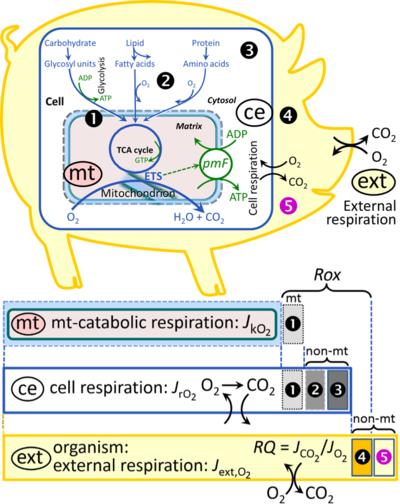
- In view of the broad implications for health care, mitochondrial researchers face an increasing responsibility to disseminate their fundamental knowledge and novel discoveries to a wide range of stakeholders and scientists beyond the group of specialists. This requires implementation of a commonly accepted terminology within the discipline and standardization in the translational context. Authors, reviewers, journal editors, and lecturers are challenged to collaborate with the aim to harmonize the nomenclature in the growing field of mitochondrial physiology and bioenergetics, from evolutionary biology and comparative physiology to mitochondrial medicine. In the present communication we focus on the following concepts in mitochondrial physiology:
- Aerobic respiration depends on the coupling of phosphorylation (ADP → ATP) to O2 flux in catabolic reactions. Coupling in oxidative phosphorylation is mediated by the translocation of protons across the inner mitochondrial membrane through proton pumps generating or utilizing the protonmotive force, that is maintained between the mitochondrial matrix and intermembrane compartment or outer mitochondrial space. Compartmental coupling distinguishes this vectorial component of oxidative phosphorylation from glycolytic fermentation as the counterpart of cellular core energy metabolism (Fig. 1). Cell respiration is distinguished from fermentation: (1) Electron acceptors are supplied by external respiration for the maintenance of redox balance, whereas fermentation is characterized by an internal electron acceptor produced in intermediary metabolism. In aerobic cell respiration, redox balance is maintained by O2 as the electron acceptor. (2) Compartmental coupling in vectorial oxidative phosphorylation contrasts to exclusively scalar substrate-level phosphorylation in fermentation.
- When measuring mitochondrial metabolism, the contribution of fermentation and other cytosolic interactions must be excluded from analysis by disrupting the barrier function of the plasma membrane. Selective removal or permeabilization of the plasma membrane yields mitochondrial preparations—including isolated mitochondria, tissue and cellular preparations—with structural and functional integrity. Subsequently, extra-mitochondrial concentrations of fuel substrates, ADP, ATP, inorganic phosphate, and cations including H+ can be controlled to determine mitochondrial function under a set of conditions defined as coupling control states. We strive to incorporate an easily recognized and understood, concept-driven terminology of bioenergetics with explicit terms and symbols that define the nature of respiratory states.
- Mitochondrial coupling states are defined according to the control of respiratory oxygen flux by the protonmotive force. Capacities of oxidative phosphorylation and electron transfer are measured at kinetically saturating concentrations of fuel substrates, ADP and inorganic phosphate, and O2, or at optimal uncoupler concentrations, respectively, in the absence of Complex IV inhibitors such as NO, CO, or H2S. Respiratory capacity is a measure of the upper bound of the rate of respiration; it depends on the substrate type undergoing oxidation, and provides reference values for the diagnosis of health and disease, and for evaluation of the effects of Evolutionary background, Age, Gender and sex, Lifestyle and Environment.
- Incomplete tightness of coupling, i.e., some degree of uncoupling relative to the substrate-dependent coupling stoichiometry, is a characteristic of energy-transformations across membranes. Uncoupling is caused by a variety of physiological, pathological, toxicological, pharmacological and environmental conditions that exert an influence not only on the proton leak and cation cycling, but also on proton slip within the proton pumps and the structural integrity of the mitochondria. A more loosely coupled state is induced by stimulation of mitochondrial superoxide formation and the bypass of proton pumps. In addition, the use of protonophores represents an experimental uncoupling intervention to asses the transition from a well-coupled to a noncoupled state of mitochondrial respiration.
- Respiratory oxygen consumption rates have to be carefully normalized to enable meta-analytic studies beyond the question of a particular experiment. Therefore, all raw data on rates and variables for normalization should be published in an open access data repository. Normalization of rates for: (1) the number of objects (cells, organisms); (2) the volume or mass of the experimental sample; and (3) the concentration of mitochondrial markers in the experimental chamber are sample-specific normalizations, which are distinguished from system-specific normalization for the volume of the chamber (the measuring system).
- The consistent use of terms and symbols will facilitate transdisciplinary communication and support the further development of a collaborative database on bioenergetics and mitochondrial physiology. The present considerations are focused on studies with mitochondrial preparations. These will be extended in a series of reports on pathway control of mitochondrial respiration, respiratory states in intact cells, and harmonization of experimental procedures.
- In view of the broad implications for health care, mitochondrial researchers face an increasing responsibility to disseminate their fundamental knowledge and novel discoveries to a wide range of stakeholders and scientists beyond the group of specialists. This requires implementation of a commonly accepted terminology within the discipline and standardization in the translational context. Authors, reviewers, journal editors, and lecturers are challenged to collaborate with the aim to harmonize the nomenclature in the growing field of mitochondrial physiology and bioenergetics, from evolutionary biology and comparative physiology to mitochondrial medicine. In the present communication we focus on the following concepts in mitochondrial physiology:
Section 2: Oxidative phosphorylation and coupling states in mitochondrial preparations
Figure 2. Cell respiration and oxidative phosphorylation (OXPHOS). Mitochondrial respiration is the utilization of fuel substrates (electron donors) for electron transfer to O2 as the electron acceptor. For explanation of symbols see also Figure 1. (A) Respiration in intact cells: Mitochondrial fuel substrates are the products of extra-mitochondrial catabolism of macrofuels or are taken up by the cell as small molecules. Many fuel substrates are catabolized to acetyl-CoA or glutamate, and further electron transfer reduces nicotinamide adenine dinucleotide to NADH or flavin adenine dinucleotide to FADH2. In aerobic respiration, electron transfer is coupled to the phosphorylation of ADP to ATP, with energy transformation mediated by the protonmotive force, pmf. Anabolic reactions are linked to catabolism, both by ATP as the intermediary energy currency and by small organic precursor molecules as building blocks for biosynthesis (not shown). Glycolysis involves substrate-level phosphorylation of ADP to ATP in fermentation without utilization of O2. In contrast, extra-mitochondrial oxidation of fatty acids and amino acids proceeds partially in peroxisomes without coupling to ATP production: acyl-CoA oxidase catalyzes the oxidation of FADH2 with electron transfer to O2; amino acid oxidases oxidize flavin mononucleotide FMNH2 or FADH2. Coenzyme Q, Q, and the cytochromes b, c, and aa3 are redox systems of the mitochondrial inner membrane, mtIM. Dashed arrows indicate the connection between the redox proton pumps (respiratory Complexes CI, CIII and CIV) and the transmembrane pmf. Mitochondrial outer membrane, mtOM; glycerol-3-phosphate, Gp; tricarboxylic acid cycle, TCA cycle.
(B) Respiration in mitochondrial preparations: The mitochondrial electron transfer system (ETS) is fuelled by diffusion and transport of substrates across the mitochondrial outer and inner membrane and consists of the matrix-ETS and membrane-ETS. ET-pathways are coupled to the phosphorylation-pathway. ET-pathways converge at the N-junction and Q-junction. Additional arrows indicate electron entry into the Q-junction through electron transferring flavoprotein, glycerophosphate dehydrogenase, dihydro-orotate dehydrogenase, choline dehydrogenase, and sulfide-ubiquinone oxidoreductase. The dotted arrow indicates the branched pathway of oxygen consumption by alternative quinol oxidase (AOX). The H+pos/O2 ratio is the outward proton flux from the matrix space to the positively (pos) charged vesicular compartment, divided by catabolic O2 flux in the NADH-pathway. The H+neg/P» ratio is the inward proton flux from the inter-membrane space to the negatively (neg) charged matrix space, divided by the flux of phosphorylation of ADP to ATP. These are not fixed stoichiometries due to ion leaks and proton slip.
(C) OXPHOS coupling: O2 flux through the catabolic ET-pathway, JkO2, is coupled by the H+ circuit to flux through the phosphorylation-pathway of ADP to ATP, JP».
(D) Phosphorylation-pathway catalyzed by the proton pump F1FO-ATPase (F-ATPase, ATP synthase), adenine nucleotide translocase, and inorganic phosphate transporter. The H+neg/P» stoichiometry is the sum of the coupling stoichiometry in the F-ATPase reaction (2.7 H+pos from the positive intermembrane space, 2.7 H+neg to the matrix, i.e., the negative compartment) and the proton balance in the translocation of ADP3-, ATP4- and Pi2-. Modified from (B) Lemieux et al 2017 and (C) Gnaiger 2014 MitoPathways.
Section 3: Normalization: fluxes and flows
Figure 6B. Flow per cell [amol O2∙s-1∙cell-1] is the product of mitochondria-specific flux, mt-density and mass per cell. Unstructured analysis: performance is the product of mass-specific flux and size (mass per cell). Structured analysis: performance is the product of mitochondrial function (mt-specific flux) and structure (mt-content).
Concept
- Citation
- MitoEAGLE Task Group (2018) Mitochondrial respiratory states and rates. 2019-01-24(52) - http://www.mitoeagle.org/index.php/MitoEAGLE_preprint_States_and_rates.
- Citation
- Acknowledgements: We thank M. Beno for management assistance. This publication is based upon work from COST Action CA15203 MitoEAGLE, supported by COST (European Cooperation in Science and Technology), and K-Regio project MitoFit (EG).
- To coauthors, editors, reviewers, and readers
- The global MitoEAGLE network made it possible to collaborate with 500 coauthors to reach consensus on the present manuscript. Nevertheless, we do not consider scientific progress to be supported by ‘declaration’ statements (other than on ethical or political issues). Our manuscript aims at providing arguments for further debate rather than pushing opinions. We hope to initiate a much broader process of discussion and want to raise the awareness on the importance of a consistent terminology for the reporting of scientific data in the field of bioenergetics, mitochondrial physiology and pathology. Quality of research requires quality of communication. Some established researchers in the field may not want to re-consider the use of jargon which has become established despite deficiencies of accuracy and meaning. In the long run, superior standards will become accepted. We hope to contribute to this evolutionary process, with an emphasis on harmonization rather than standardization.
- To coauthors, editors, reviewers, and readers
Authors
- This is an open invitation to scientists and students to join as coauthors, to provide a balanced view on mitochondrial respiratory control and a consensus statement on reporting data of mitochondrial respiration in terms of metabolic flows and fluxes.
- Coauthors: Confirming to have read the final manuscript, possibly to have made additions or suggestions for improvement, and to agree to implement the recommendations into future manuscripts, presentations and teaching materials. (alphabetical)
- We continue to invite comments and suggestions, particularly if you are an early career investigator adding an open future-oriented perspective, or an established scientist providing a balanced historical basis. Your critical input into the quality of the manuscript will be most welcome, improving our aims to be educational, general, consensus-oriented, and practically helpful for students working in mitochondrial respiratory physiology.
- To join as a coauthor, please feel free to focus on a particular section, providing direct input and references, and contributing to the scope of the manuscript from the perspective of your expertise. Your comments will be considered as appropriate in the manuscript and will be largely posted on the discussion page of the MitoEAGLE preprint website.
- If you prefer to submit comments in the format of a referee's evaluation rather than a contribution as a coauthor, we will be glad to distribute your views to the updated list of coauthors for a balanced response. We would ask for your consent on this open bottom-up policy.
Disclaimer
- This article was prepared while Joshua P. Fessel was employed at Vanderbilt University Medical Center. The opinions expressed in this article are the author's own and do not reflect the view of the National Institutes of Health, the Department of Health and Human Services, or the United States government.
Linking COST Actions
- » Manuscript phases and versions
Manuscript phases and versions - an open-access apporach
- This manuscript on ‘Mitochondrial respiratory states and rates’ is a position statement in the frame of COST Action CA15203 MitoEAGLE. The list of coauthors evolved beyond phase 1 in the bottom-up spirit of COST.
- The global MitoEAGLE network made it possible to collaborate with a large number of coauthors to reach consensus on the present manuscript. Nevertheless, we do not consider scientific progress to be supported by ‘declaration’ statements (other than on ethical or political issues). Our manuscript aims at providing arguments for further debate rather than pushing opinions. We hope to initiate a much broader process of discussion and want to raise the awareness on the importance of a consistent terminology for reporting of scientific data in the field of bioenergetics, mitochondrial physiology and pathology. Quality of research requires quality of communication. Some established researchers in the field may not want to re-consider the use of jargon which has become established despite deficiencies of accuracy and meaning. In the long run, superior standards will become accepted. We hope to contribute to this evolutionary process, with an emphasis on harmonization rather than standardization.
- Phase 1: The protonmotive force and respiratory control
- » The protonmotive force and respiratory control - Discussion
- 2016-11 MitoEAGLE Verona 2016
- 2017-03 MitoEAGLE Barcelona 2017
- 2017-04-09 to 2017-09-18 (44 versions)
- 2017-07 MiPschool Obergurgl 2017
- 2017-09-21 to 2018-02-06 (21 versions)
- » MitoEAGLE preprint 2017-09-21 - Discussion
- 2017-11-11: Print version (16) for MiP2017/MitoEAGLE Hradec Kralove CZ
- Phase 2: Mitochondrial respiratory states and rates: Building blocks of mitochondrial physiology Part 1
- » MitoEAGLE Task Group States and rates - Discussion
- 2018-02-08 (42 versions up to present)
- 2018-08 EBEC2018 Budapest HU - Poster
- 2018-09 MiP2018/MitoEAGLE Jurmala LV
- 2018-10 MiPschool Tromso-Bergen 2018
- Phase 3: 2019-02-12: Publication as a preprint: MitoFit Preprints with DOI number, providing widely accepted visible proof that the publication is citable. - See MitoFit DOI Data Center (2018-12-12 submission).
- Phase 4: Journal submission
- Target: CELL METABOLISM, aiming at indexing by The Web of Science and PubMed.
- Coauthors
- 2017-09-21 Version 01: 105 coauthors
- 2017-10-15 Version 10: 131 coauthors
- 2018-01-18 Version 20: 168 coauthors
- 2018-02-26 Version 30: 225 coauthors
- 2018-08-20 Version 40: 350 coauthors - EBEC Poster
- 2018-10-17 Version 44: 426 coauthors - MiPschool Tromso-Bergen 2018
- 2018-12-12 Version 50: 517 coauthors - Submission to the preprint server bioRxiv not successful
- 2019-02-12 Preprint version 1: 530 coauthors
- 2019-03-15 Preprint version 2: 533 coauthors
- 2019-04-24 Preprint version 3: 533 coauthors
- 2019-05-20 Preprint version 4: 542 coauthors
- 2019-07-24 Preprint version 5: 612 coauthors
- 2019-08-30 Preprint version 6: 622 coauthors - Preprint publication doi:10.26124/mitofit:190001.v6
- Coauthors
- BEC 2020.1. - Gnaiger Erich et al ― MitoEAGLE Task Group (2020) Mitochondrial physiology. Bioenerg Commun 2020.1. doi:10.26124/bec:2020-0001.v1. - »Bioblast link«
- We plan a series of follow-up reports by the expanding MitoEAGLE Network, to increase the scope of harmonization and facilitate global communication and collaboration. Further discussions: MitoEAGLE events.
MitoEAGLE preprint 1: Poster
- Presented at MiPschool Tromso-Bergen 2018
- Presented at EBEC2018 Budapest HU
Letter to the Editors of scientific journals
- Dear Editors:
- We would like to ask you for your opinion about the increasingly urgent issue of nomenclature in mitochondrial physiology.
- With your collaboration our goal is to make publications with data on mitochondrial respiration more generally comprehensible and data more universally useful by bringing better standardization of nomenclature and data presentation to the field.
- As the knowledge base and importance of mitochondrial physiology to human health expand, the necessity for harmonizing nomenclature concerning mitochondrial respiratory states and rates has become increasingly apparent. In the frame of COST Action MitoEAGLE, we endeavour to provide a balanced view on mitochondrial respiratory control and a critical discussion on reporting data of mitochondrial respiration. Uniform standards for evaluation of respiratory states and rates will ultimately support the development of databases of mitochondrial respiratory function in species, tissues, and cells.
- A Working Group of the COST Action MitoEAGLE is preparing a document on ‘Mitochondrial respiratory states and rates’. The group is working on it with Open Access as a ‘MitoEAGLE preprint’ and the ultimate aim of publication in a scientific journal:
- We would like to include your opinion as editor. We aim at providing a list of journals, from whom we received valuable feedback:
- Do you recognize a general need for a consensus on nomenclature and standards of reporting in the field of mitochondrial respiratory physiology?
- Can you provide comments and suggestions for the MitoEAGLE preprint: 'Mitochondrial respiratory states and rates’ from your point of view as an editor?
- Which further steps do you suggest towards implementing a harmonized terminology on mitochondrial states and rates in your editorial policy?
- We would like to include your opinion as editor. We aim at providing a list of journals, from whom we received valuable feedback:
- I thank you for your considerations.
- With kind regards,
- Erich Gnaiger, Ph.D.
- Chair COST Action CA15203 MitoEAGLE - http://www.mitoeagle.org
- Chair Mitochondrial Physiology Society - http://www.mitophysiology.org
- Medical University of Innsbruck
- Department of Visceral, Transplant and Thoracic Surgery
- D. Swarovski Research Laboratory
- A-6020 Innsbruck, Austria
- Email: [email protected]
MitoPedia
Labels:
MitoEAGLEPublication






